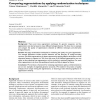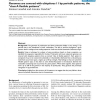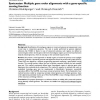50 search results - page 2 / 10 » What can we learn from noncoding regions of similarity betwe... |
BMCBI
2007
13 years 5 months ago
2007
Background: There exist many segmentation techniques for genomic sequences, and the segmentations can also be based on many different biological features. We show how to evaluate ...
BMCBI
2006
13 years 5 months ago
2006
Background: Genomic tiling micro arrays have great potential for identifying previously undiscovered coding as well as non-coding transcription. To-date, however, analyses of thes...
CVPR
2011
IEEE
13 years 1 months ago
2011
IEEE
The goal of object category discovery is to automatically identify groups of image regions which belong to some new, previously unseen category. This task is typically performed i...
BMCBI
2005
13 years 5 months ago
2005
Background: The genomes of prokaryotes and lower eukaryotes display a very strong 11 bp periodic bias in the distribution of their nucleotides. This bias is present throughout a g...
ALMOB
2008
13 years 5 months ago
2008
Background: Identification of homologous regions or conserved syntenies across genomes is one crucial step in comparative genomics. This task is usually performed by genome alignm...



